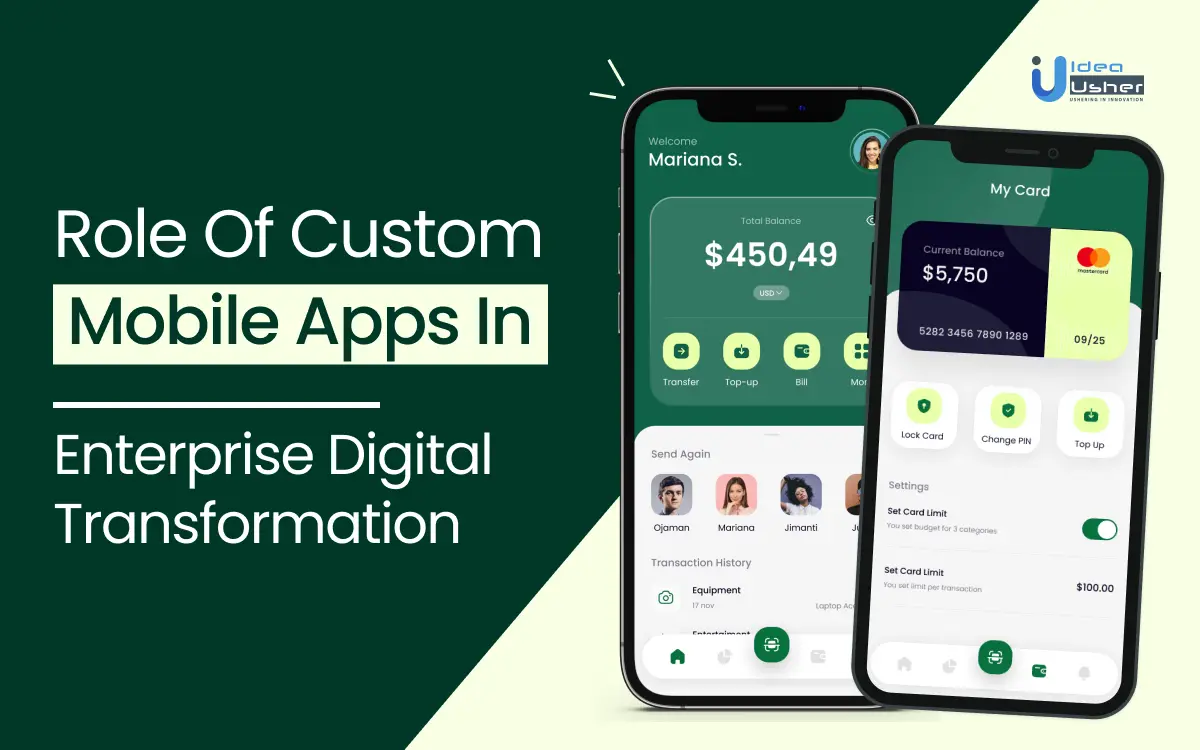In today’s fast-paced business environment, embracing digital transformation has become essential for organizations across all sectors and sizes. This shift towards digitization is not merely advantageous but necessary for organizations striving to remain competitive and relevant in the modern market landscape.
However, navigating the complexities of digital transformation, particularly in aligning digital offerings with evolving customer demands, presents significant challenges. This is where the strategic integration of custom mobile applications becomes indispensable.
Mobile apps play a pivotal role in facilitating enterprise digital transformation by offering a seamless pathway for organizations to adapt to evolving technological landscapes. With the integration of advanced technologies such as AI, ML, and IoT, mobile applications are increasingly leveraged to enhance organizational efficiency and productivity.
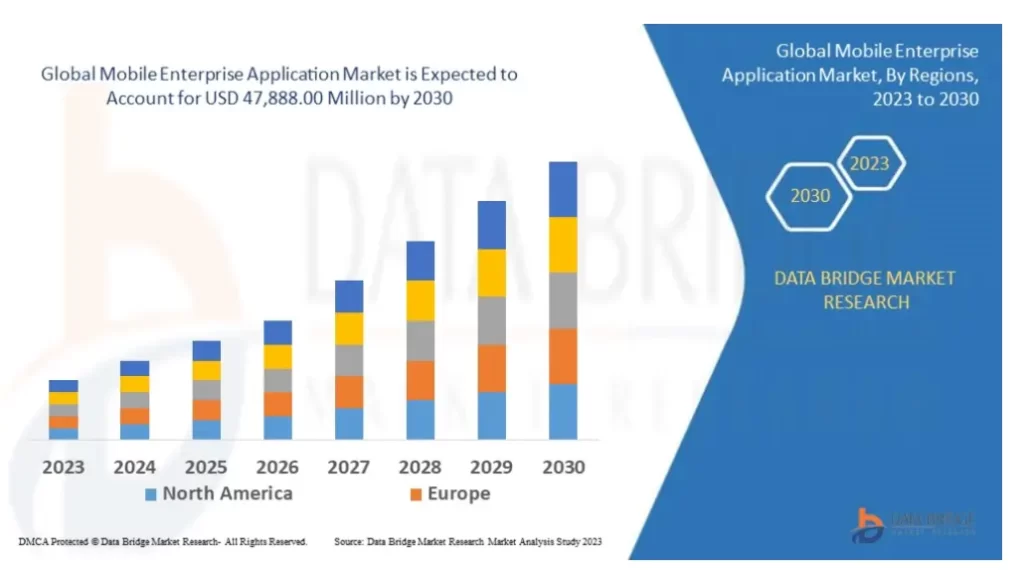
Source: DataBridgeMarket
While statistics show that mobile apps are growing rapidly, the purpose of this blog is to explain the critical role mobile applications play in enabling digital business transformation. Also, explore the key benefits and process of investing in mobile app development to fuel digital transformation efforts.
Why Enterprises Should Invest in Mobile Apps For Digital Transformation?
Enterprise mobile applications facilitate seamless connectivity for employees to engage with the core operations of the business, regardless of their physical location. Consequently, this dynamic fosters enhanced employee experiences and boosts overall team productivity.
1. Enhancing Productivity and Efficiency
Enterprise mobile applications significantly enhance productivity and efficiency by providing employees with seamless access to critical business processes, data, and tools from anywhere, at any time. This flexibility is particularly beneficial for remote workers, field agents, or employees who frequently travel. Through mobile apps, employees can complete tasks, collaborate with colleagues, and make informed decisions on-the-go, without being tethered to their desks. This boosts overall productivity and efficiency as work can continue uninterrupted, even outside traditional office environments. Furthermore, mobile apps often integrate with other software systems used within the organization, streamlining workflows and reducing time spent on manual data entry or switching between multiple platforms. This integration fosters a more cohesive and efficient work environment.
2. Streamlining Workflow Processes
Mobile software systems empower organizational leaders with valuable insights into team performance, allowing them to identify bottlenecks, inefficiencies, and areas for improvement in real-time. By analyzing data collected through mobile apps, organizations can implement targeted optimizations to streamline workflows and enhance productivity. Automation features within mobile apps enable the elimination of repetitive tasks, freeing up employees to focus on more strategic and value-added activities. This not only reduces the likelihood of human error but also accelerates the pace of work and ensures consistency in processes. Additionally, workflow optimization apps facilitate the creation of predefined rules and workflows, automating decision-making processes and ensuring tasks are routed efficiently to the appropriate individuals or teams. This enhances overall operational efficiency and agility within the organization.
3. Elevating Customer Satisfaction
Mobile applications play a pivotal role in enhancing customer engagement and satisfaction by providing seamless access to products, services, and support channels. Through personalized experiences and targeted communications, businesses can strengthen relationships with their customers and drive loyalty. Digital mobile apps leverage advanced analytics and machine learning algorithms to analyze customer behavior, preferences, and feedback, allowing organizations to tailor their offerings and marketing strategies accordingly. This leads to more relevant and compelling interactions with customers, ultimately increasing satisfaction and retention rates. Moreover, mobile apps enable instant communication and support through features such as live chat, chatbots, and push notifications. This ensures prompt responses to customer inquiries, issue resolution, and proactive engagement, fostering a positive and frictionless customer experience.
4. Enhancing Organizational Transparency
Mobile apps provide employees with real-time access to relevant information, updates, and resources, regardless of their location, promoting collaboration, informed decision-making, and alignment across teams and departments. By leveraging mobile apps, organizations can facilitate seamless communication and information sharing among employees, ensuring everyone is on the same page and working towards common goals. This transparency fosters a culture of accountability, trust, and teamwork within the organization. Additionally, mobile apps can incorporate features such as GPS tracking and task management, allowing managers to monitor progress, track work activities, and allocate resources more effectively. This transparency enables proactive problem-solving and resource optimization, driving operational excellence and performance improvement.
Custom Mobile Apps And Their Role In Digital Transformation
Businesses often view mobile applications as standalone entities rather than recognizing their pivotal role as catalysts in digital business transformation. However, it’s crucial to understand that mobile apps can significantly accelerate the pace of digital transformation and contribute to an organization’s overall success.
1. Harnessing AI in Mobile Apps
The integration of AI technologies into mobile applications has revolutionized customer experiences and transformed marketing strategies. Leveraging AI, such as natural language processing, generation, speech recognition, chatbots, and biometrics, enables businesses to develop intuitive mobile apps that adapt to user preferences and behaviors. In the enterprise context, AI-powered mobility applications empower employees with enhanced intelligence and capabilities, leading to heightened productivity and satisfaction. From automating processes to providing predictive analytics and personalized customer service, AI-driven mobile apps are reshaping the digital landscape.
2. Utilizing IoT in Mobile Apps
Mobile apps are increasingly incorporating IoT functionalities to enhance operational efficiency and transparency across enterprises. Gone are the days when IoT was solely utilized for displaying products and sharing information. Today, businesses are leveraging IoT-enabled mobile apps to manage smart equipment in offices and streamline supply chain operations. Although IoT digital apps are relatively nascent in the enterprise sector, they are rapidly gaining traction as organizations recognize their potential to drive innovation and optimize business processes.
3. Leveraging Real-Time Analytics for Informed Decision-Making
Access to real-time data analytics through mobile apps provides organizations with a competitive edge in today’s fast-paced business environment. By collecting user data and analyzing app usage patterns, businesses can tailor marketing messages, optimize team performance, and identify operational challenges. Real-time analytics empower decision-makers to respond promptly to market trends, customer needs, and internal dynamics, driving agility and strategic alignment within the organization.
4. Enhancing Portability and Flexibility
Mobile apps enhance portability and flexibility within the enterprise ecosystem, enabling employees to work anytime, anywhere. While the immediate impact may seem modest, the long-term benefits of increased flexibility are substantial. Empowering employees to work according to their preferences fosters creativity, collaboration, and productivity. By embracing mobile-enabled workflows, organizations can unlock new levels of efficiency, innovation, and employee satisfaction, ultimately driving business growth and competitiveness.
5. Serving as the Digital Face of the Organization
In today’s digital era, mobile apps serve as the primary interface between businesses and their customers, shaping brand perceptions and driving engagement. A well-designed mobile app not only facilitates transactions but also embodies the organization’s brand identity and values. By integrating mobile applications into their digital strategy, businesses can deliver personalized experiences, foster customer loyalty, and differentiate themselves in the market. Mobile apps have become indispensable tools for businesses seeking to stay relevant, competitive, and customer-centric in an increasingly mobile-first world.
Top Trends In A Custom Enterprise Mobile App Development
Explores the top trends driving the evolution of custom enterprise mobile app development, empowering businesses to harness the full potential of mobile technology for strategic advantage.
1. Cross-platform development
Enterprises are increasingly turning to cross-platform development frameworks such as React Native, Flutter, and Xamarin to streamline the development process across different platforms. These frameworks offer advantages such as code reusability, which significantly reduces development time and costs. Moreover, by maintaining a single codebase, developers can ensure consistency in features and user experience across iOS and Android devices. Additionally, cross-platform development allows for quicker updates and easier maintenance, as changes need to be implemented only once for all platforms, enhancing agility and scalability for enterprise mobile app development projects.
2. Progressive Web Apps (PWAs)
Progressive Web Apps (PWAs) are gaining traction in enterprise mobile app development due to their ability to combine the best of both web and native mobile apps. PWAs offer features like offline access, push notifications, and fast loading times, making them highly engaging for users. Enterprises appreciate PWAs for their cost-effectiveness and ease of distribution, as they can be accessed directly through web browsers without requiring installation from app stores. Furthermore, PWAs are inherently responsive, providing a consistent experience across various devices, which is advantageous for enterprises targeting diverse user bases.
3. Integration of AI and ML
Artificial intelligence (AI) and machine learning (ML) technologies are being seamlessly integrated into enterprise mobile apps to deliver personalized experiences and improve operational efficiency. AI-powered features such as chatbots enhance customer support by providing instant responses to queries, while recommendation engines offer tailored content and product suggestions, boosting engagement and conversion rates. ML algorithms analyze vast amounts of data to generate actionable insights, enabling enterprises to make data-driven decisions and anticipate customer needs. Automation of repetitive tasks through AI and ML not only increases productivity but also frees up resources for strategic initiatives within the organization.
4. Internet of Things (IoT) integration
The integration of Internet of Things (IoT) devices and sensors into enterprise mobile apps opens up new possibilities for data collection, analysis, and automation. Custom enterprise mobile apps interact with IoT devices to enable functionalities such as remote monitoring, predictive maintenance, and real-time asset tracking. By harnessing IoT data, enterprises gain valuable insights into operational performance, resource utilization, and customer behavior, driving informed decision-making and process optimization. Furthermore, IoT-enabled mobile apps enhance connectivity and collaboration among employees, facilitating seamless communication and workflow management across distributed teams.
5. Augmented Reality (AR) and Virtual Reality (VR)
Augmented Reality (AR) and Virtual Reality (VR) technologies are revolutionizing enterprise mobile app development by providing immersive and interactive experiences across various industries. Enterprises leverage AR/VR solutions for product visualization, allowing customers to preview products in real-world environments before making purchasing decisions. In sectors like healthcare and manufacturing, AR/VR simulations are used for training purposes, enabling employees to practice complex procedures in a safe and controlled environment. Moreover, AR/VR-enhanced mobile apps facilitate virtual meetings and collaborative design sessions, breaking down geographical barriers and fostering innovation and creativity within organizations.
How To Develop A Custom Mobile App For Enterprises?
This guide will walk you through the process of creating a custom mobile app tailored for enterprises. You’ll receive comprehensive instructions to kickstart your app development journey, along with valuable resources to support you in building your inaugural app.
Step 1: Defining the strategies and ideas
Mobile apps represent one of the fastest-growing sectors globally, with a projected revenue of over $100 billion annually, a figure expected to rise. To maximize the effectiveness of app development efforts, it’s imperative to establish a clear vision for the app’s purpose. One effective approach is crafting a storyboard to outline the app’s functionality and user experience.
Initially, decide on the features your app should encompass, ensuring alignment with your business objectives. Subsequently, selecting the appropriate platform for development is crucial, considering factors like target audience demographics and market reach. Collaborating with the right developer who possesses the requisite expertise is essential for project success.
Comprehensive information gathering is paramount, encompassing market research, user feedback, and competitor analysis. With these foundational steps completed, app creation can commence, involving iterative development, testing, and refinement cycles.
Continuous maintenance and updates are vital to keep the app relevant and functional, necessitating ongoing collaboration with the development team. Soliciting user feedback and conducting A/B testing enable fine-tuning for optimal user satisfaction and engagement. Ultimately, witnessing the tangible outcomes of diligent development efforts validates the investment in app creation.
Step 2: Defining your mobile app’s target audiences
Identifying the target audience is pivotal in shaping the app’s design, functionality, and marketing strategy. Understanding demographic characteristics such as age, gender, location, and interests helps tailor the app to meet specific user needs.
Determining the size of the target audience provides insights into market potential and scalability. Moreover, discerning which user segments exhibit the most interest in the app aids in prioritizing features and optimizing user experience.
Analyzing user behavior and preferences elucidates where and how users are likely to engage with the app, informing decisions regarding platform compatibility and interface design. Continuously refining audience targeting through data-driven insights ensures the app remains relevant and resonates with its intended users.
Step 3: Finding an expert to develop your custom mobile app
Engaging a proficient development team is critical to navigate the complexities of app development and mitigate potential pitfalls. Leveraging reputable app development companies facilitates access to seasoned professionals equipped with the requisite skills and resources.
Exploring options such as Designveloper, a renowned app developer in Vietnam, ensures access to comprehensive support throughout the development lifecycle. Local expertise combined with tailored guidance streamlines the development process and enhances project outcomes.
Partnering with organizations like AppLift offers invaluable training and resources to empower entrepreneurs in embarking on their app development journey. Leveraging their expertise and industry insights equips individuals with the knowledge and skills to navigate the app development landscape confidently.
Step 4: Develop your custom mobile app
Embarking on the development journey necessitates a clear understanding of the app’s objectives and target audience preferences. Identifying user needs and pain points informs the design and functionality of the app, ensuring alignment with customer expectations.
While developing proprietary apps offers unique value propositions, it entails significant investment and expertise. Exploring options like hiring developers or enrolling in technical courses enables individuals to acquire the skills needed for app development.
Step 5: Testing your mobile app
Ensuring app usability and functionality is paramount, necessitating rigorous testing across multiple devices and operating systems. Leveraging an array of testing tools facilitates comprehensive evaluation and identifies potential issues or compatibility issues.
Availing both free and premium testing services enhances confidence in the app’s performance and user experience. Investing in robust testing protocols minimizes post-deployment issues and fosters user satisfaction and loyalty.
Step 6: Deployment & Support
Upon app deployment, ongoing support and maintenance are crucial for sustaining user engagement and satisfaction. Implementing promotional strategies and monitoring download metrics enable continuous optimization and growth.
Engaging users through feedback mechanisms and performance monitoring facilitates iterative enhancements and fosters a loyal user base. Analyzing user behavior and conversion rates informs strategic decisions and ensures the app remains competitive and impactful in the marketplace.
Examples Of Companies Benefited From Custom Mobile App Development
Through custom mobile applications, companies like Netflix, Amazon, Uber, and others have successfully addressed challenges unique to their sectors, driving growth and innovation in the digital age.
1. Netflix
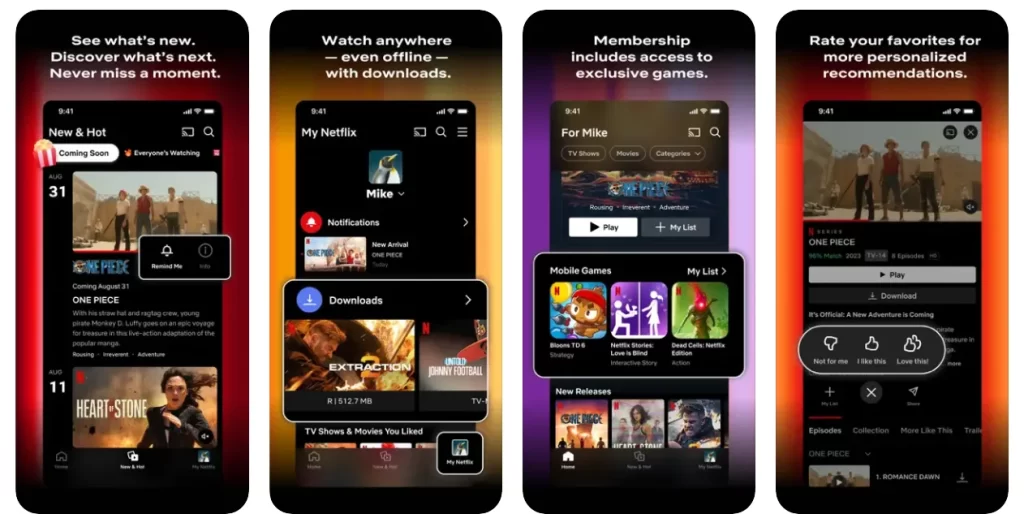
Traditional entertainment distribution methods like cable TV and DVD rentals were becoming outdated as consumers increasingly preferred digital streaming. Netflix needed to adapt to this shift and provide a seamless, personalized streaming experience to attract and retain customers. Furthermore, the proliferation of streaming competitors meant that Netflix had to differentiate itself with compelling content and innovative features. Balancing licensing costs and content acquisition while keeping subscription prices competitive was another challenge. Moreover, ensuring a consistent streaming experience across various devices and internet connections was crucial for customer satisfaction. Addressing concerns over data privacy and security in an era of increasing cyber threats added complexity to their technological development efforts.
Solution
Netflix developed a bespoke mobile app that leveraged advanced algorithms to personalize recommendations, optimize streaming quality, and enable seamless transitions between devices.
Results
The app has been instrumental in Netflix’s growth, significantly expanding its subscriber base and dominating the streaming market. Its intuitive interface and personalized content recommendations have led to increased user engagement and satisfaction. Moreover, Netflix continues to innovate with features like offline viewing and interactive content, further enhancing the app’s value proposition and solidifying its position as a leader in the entertainment industry.
2. Amazon
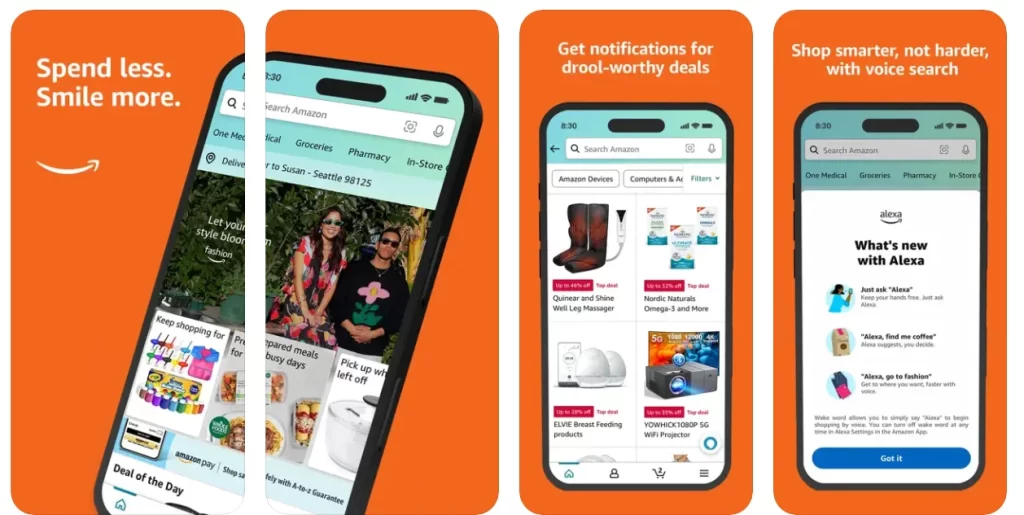
With the rise of e-commerce, Amazon faced stiff competition from both traditional brick-and-mortar retailers and emerging online platforms. To maintain its market position and meet evolving customer expectations, Amazon needed to enhance the convenience and personalization of its shopping experience. Additionally, ensuring the reliability and security of online transactions was paramount to building trust with customers. Addressing concerns over counterfeit products and fraudulent sellers on the platform required robust verification and enforcement measures. Moreover, optimizing the supply chain and logistics operations to enable fast and cost-effective delivery posed significant challenges, especially during peak shopping seasons. Balancing the expansion of product offerings with maintaining a user-friendly shopping interface required careful product design and navigation. Furthermore, Amazon had to address sustainability concerns related to packaging and shipping practices, responding to growing consumer demand for eco-friendly options.
Solution
Amazon introduced a custom mobile app offering one-click purchasing, personalized product recommendations based on user behavior, and real-time order tracking to enhance the overall shopping experience.
Results
The app has transformed the way people shop, contributing to Amazon’s dominance in the e-commerce industry. Its user-friendly interface and seamless shopping experience have led to increased customer loyalty and higher conversion rates. Additionally, Amazon has leveraged the app to integrate other services like Prime Video and Amazon Music, creating a comprehensive ecosystem that enhances user engagement and loyalty.
3. Uber

Traditional taxi services often lacked convenience, reliability, and transparency in pricing. Uber aimed to disrupt this industry by providing a more convenient, on-demand transportation solution. However, it needed to overcome regulatory hurdles and establish trust among consumers wary of new ride-sharing services. Additionally, ensuring the safety and security of passengers and drivers in an environment with potential risks posed significant challenges. Addressing concerns over driver background checks, insurance coverage, and incident response protocols required robust policies and technological solutions.
Solution
Uber developed a bespoke mobile app connecting riders with drivers, enabling cashless payments, and optimizing route efficiency through real-time GPS tracking.
Results
The app has revolutionized urban transportation, becoming synonymous with convenience and reliability. Uber’s mobile app has facilitated millions of rides worldwide, transforming the way people commute and revolutionizing the concept of on-demand services. Moreover, Uber continues to innovate with features like Uber Eats, expanding its platform and further solidifying its position as a market leader in the transportation and delivery sectors.
4. Bank of America
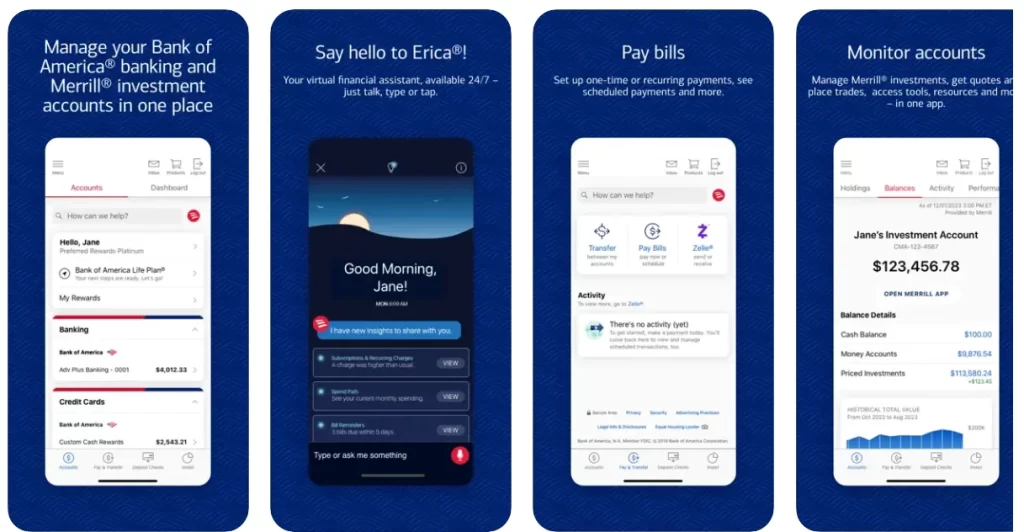
Traditional banking faced challenges from online banks and fintech startups that offered more convenient and user-friendly digital banking experiences. To stay competitive, Bank of America needed to modernize its services and provide customers with easy access to banking features on their mobile devices. Additionally, ensuring the security and integrity of customer data in an era of increasing cyber threats posed significant challenges. Addressing concerns over data breaches, identity theft, and fraud required robust cybersecurity measures and continuous monitoring.
Solution
Bank of America launched a custom mobile app offering features such as mobile banking, check depositing, and budget tracking tools to meet the evolving needs of its customers.
Results
The app has empowered customers to manage their finances conveniently from their smartphones, leading to increased account usage and customer satisfaction. Bank of America’s mobile app has enhanced its competitive edge in the banking industry and attracted a younger demographic of tech-savvy consumers. Additionally, the app’s security features, such as biometric authentication and real-time fraud alerts, have bolstered trust and confidence among users.
5. Domino’s Pizza
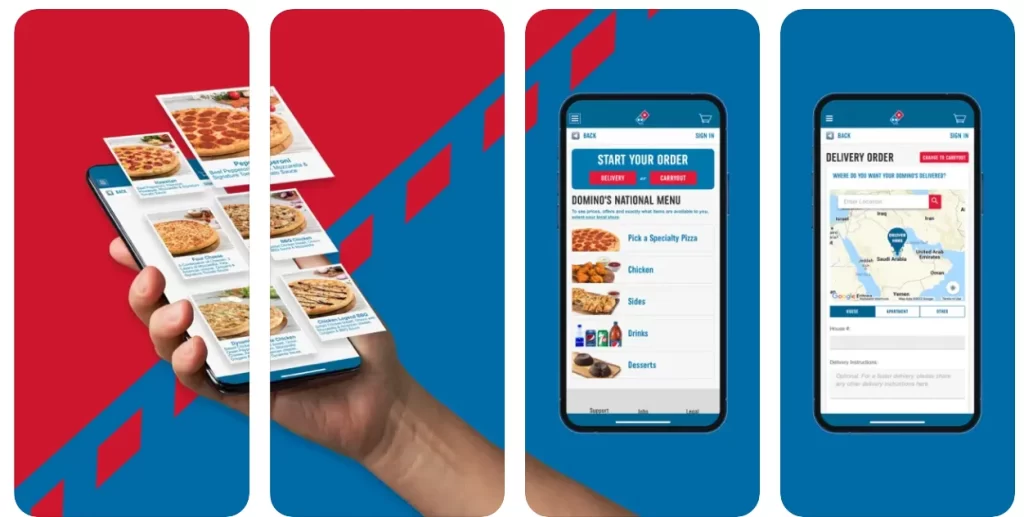
In the highly competitive fast-food industry, Domino’s faced challenges from both traditional pizza chains and emerging food delivery platforms. To differentiate itself and maintain market share, Domino’s needed to enhance the convenience and speed of its ordering and delivery processes. Additionally, ensuring the quality and freshness of food during delivery posed significant challenges, especially for maintaining customer satisfaction. Addressing concerns over food safety, hygiene, and temperature control required robust packaging and delivery protocols.
Solution
Domino’s developed a custom mobile app that streamlined the pizza ordering process, provided real-time order tracking, and enabled seamless communication between customers and delivery drivers.
Results: The app has been a game-changer, leading to increased customer satisfaction and a significant boost in online orders. Domino’s stock price has seen substantial growth since the app’s introduction, reflecting the positive impact on the company’s bottom line. Additionally, Domino’s continues to innovate with features like voice ordering and AI-driven recommendations, further enhancing the app’s value proposition and solidifying its position as a leader in the pizza delivery market.
6. Starbucks
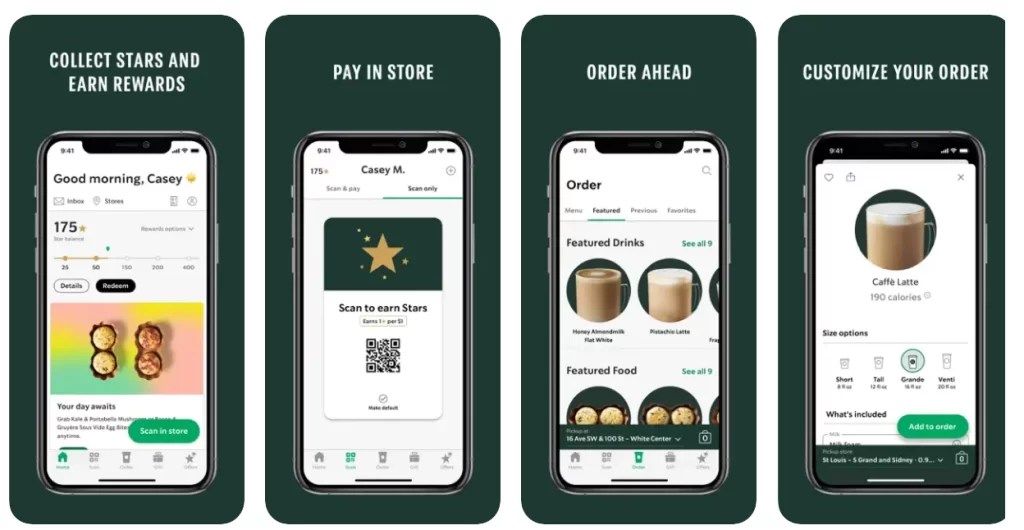
With increasing competition from local coffee shops and other chains, Starbucks needed to strengthen customer loyalty and streamline its ordering process. Additionally, it faced challenges related to long wait times during peak hours and the need for a more personalized customer experience. Addressing concerns over coffee quality and consistency across locations posed significant challenges, especially for maintaining the premium brand image. Moreover, ensuring the safety and hygiene of food and beverage offerings in an era of heightened health consciousness required rigorous sanitation protocols.
Solution
Starbucks introduced a custom mobile app that allowed customers to pay for orders using their smartphones, earn rewards, and place orders in advance to reduce wait times.
Results
The app has been a resounding success, with millions of users. It has significantly boosted customer loyalty and engagement, driving repeat business and increased spending per customer. Starbucks has also leveraged the app to launch innovative features like mobile ordering and payment integration with loyalty programs, enhancing the overall customer experience and driving continued growth for the company.
7. Walmart
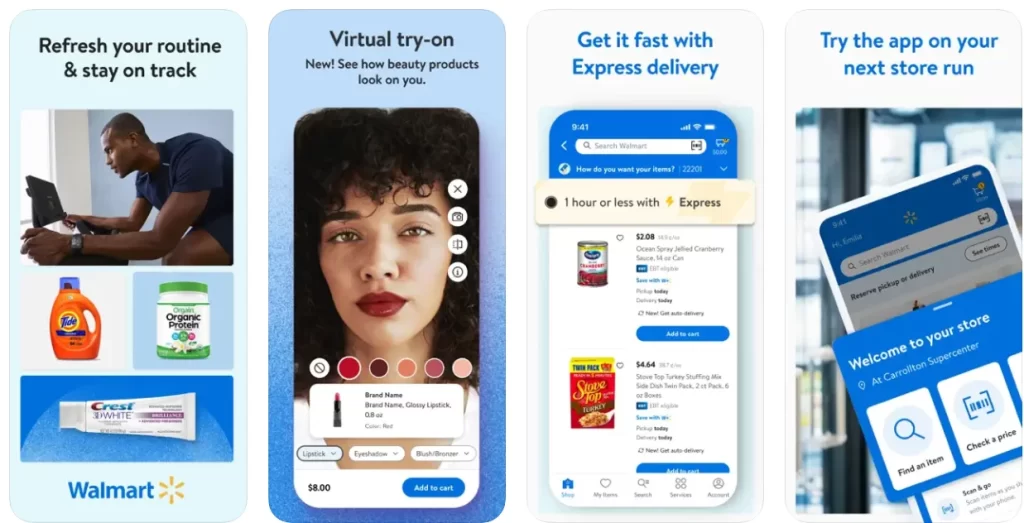
Walmart operates on a massive scale with a vast inventory and complex supply chain. Ensuring efficient inventory management, optimizing order fulfillment processes, and enhancing communication between stores and headquarters were critical challenges for Walmart to maintain profitability and meet customer demand effectively. Additionally, addressing concerns over product availability and stockouts required real-time visibility into inventory levels and demand forecasting capabilities. Moreover, optimizing store layouts and product placement to enhance the shopping experience and drive sales required data-driven insights and continuous experimentation.
Solution
Walmart developed a custom mobile app for employees to monitor inventory in real-time, streamline order fulfillment processes and enhance communication between store personnel and headquarters.
Results
The app has led to substantial cost savings and a better shopping experience for customers, as items are more consistently available on store shelves. Walmart’s mobile app has also enabled features like in-store navigation, price comparison, and personalized recommendations, further enhancing the overall shopping experience and driving customer satisfaction. Additionally, Walmart has leveraged the app to integrate with other services like grocery pickup and delivery, expanding its reach and solidifying its position as a leader in the retail industry.
Cost Affecting Factors To Consider To Develop A Custom Enertprise App
Developing a custom enterprise app entails careful consideration of various cost-affecting factors to ensure a successful and cost-effective project. In this section, we’ll explore key elements that influence the cost of developing a custom enterprise app.
1. Outsourcing vs. In-house App Development
Outsourcing vs. in-house development is a critical decision that impacts the cost of developing a custom enterprise app. Outsourcing can potentially reduce costs, especially if you choose a development team from a region with lower labor costs. However, it requires effective communication and project management to ensure successful collaboration with the remote team. On the other hand, in-house development may seem more expensive initially due to higher labor costs, but it offers better control over the development process and potentially higher quality outcomes in the long run. Considerations such as the availability of skilled talent locally, project complexity, and long-term maintenance should be factored into the decision-making process.
2. Location and Structure of a Development Team
The geographical location of your development team is a significant factor influencing costs. Hiring developers from regions with higher living standards and wages, such as North America or Western Europe, will result in higher expenses compared to regions like Eastern Europe, India, or Southeast Asia. Additionally, the structure of your development team, including the number of developers, designers, project managers, and testers, affects costs. Determining the optimal team structure requires balancing expertise and resources with budget constraints. Considerations such as time zone differences, cultural compatibility, and language proficiency should also be taken into account when selecting a development team.
3. Features and Functionality
The complexity and number of features desired in the app directly impact development costs. Basic apps with minimal features will cost less to develop, while complex apps requiring advanced functionalities such as real-time updates, social media integration, or AI-driven features will incur higher expenses. It’s essential to have detailed specifications and a clear understanding of the required features to accurately estimate development costs. Prioritizing features based on their importance to the app’s core functionality can help manage costs effectively and ensure that the final product meets the business requirements within budget constraints.
4. Android vs. iOS
Choosing between developing for Android and iOS platforms involves different considerations and costs. While Android typically has a broader user base globally, iOS users tend to spend more on apps, making it an attractive platform for monetization. The choice between these platforms impacts development time, resources, and ultimately, costs. Some businesses opt for launching on one platform first to manage initial investment and gather user feedback before expanding to other platforms, while others develop for both simultaneously to reach a wider audience. Factors such as target market demographics, app monetization strategy, and technical requirements should be considered when deciding on platform prioritization.
5. Native vs. Hybrid
The decision between native and hybrid app development has implications for both cost and performance. Native apps are built specifically for a single platform (e.g., iOS or Android) using platform-specific languages (Swift for iOS, Java/Kotlin for Android), providing better performance and user experience but requiring separate development efforts for each platform. On the other hand, hybrid apps are developed using web technologies like HTML, CSS, and JavaScript, offering cross-platform compatibility and potentially reducing development time and costs. However, hybrid apps may compromise performance compared to native apps, especially for complex or resource-intensive applications. Considerations such as target platform requirements, performance expectations, and long-term maintenance should be evaluated when choosing between native and hybrid development approaches.
6. Visual Design Complexity
The complexity of the app’s visual design, including UI/UX elements, animations, and branding, influences development costs. Simple, minimalist designs require less time and resources to implement, while intricate designs with custom animations, transitions, and branding elements increase development efforts and costs. Balancing aesthetics with functionality is crucial to ensure an engaging user experience within budget constraints. Collaborating with experienced designers and conducting user testing to iterate on the design can help achieve the desired visual appeal while managing development costs effectively.
7. Backend Infrastructure
The backend infrastructure, including servers, databases, APIs, and cloud services, is essential for app functionality, security, and scalability. The choice between building a custom backend or utilizing existing backend solutions like Backend as a Service (BaaS) affects development costs and timelines. Custom backend development offers greater flexibility and control over the infrastructure but requires more time, resources, and expertise to design, implement, and maintain. On the other hand, BaaS solutions provide convenience and cost savings by offering pre-built backend functionalities and infrastructure, but may have limitations in customization and scalability. Considerations such as data security requirements, scalability needs, and long-term maintenance should be weighed when selecting the appropriate backend infrastructure for your enterprise app.
Tech Stack To Consider To Develop A Custom Enterprise Mobile App
When developing a custom enterprise mobile app, it’s essential to select a tech stack that aligns with your project requirements, budget, timeline, and scalability needs. Here’s a recommended tech stack to consider:
1. Programming Language
- Java/Kotlin for Android: Java is the traditional choice for Android development, but Kotlin has gained popularity due to its modern features and better syntax.
- Swift for iOS: Swift is Apple’s preferred language for iOS app development. It offers better performance and safety compared to Objective-C.
2. Development Framework
- Android Studio: The official IDE for Android development.
- Xcode: The official IDE for iOS development.
3. Cross-platform Development (optional)
- React Native: Allows you to build cross-platform apps using JavaScript and React.
- Flutter: Offers a framework for building natively compiled applications for mobile, web, and desktop from a single codebase using the Dart language.
4. Backend Development
- Node.js/Express.js: For building scalable and fast backend services.
- Python/Django or Flask: Another popular option for building backend services, especially if you’re familiar with Python.
- Ruby on Rails: If your team is proficient in Ruby, Rails can be a great choice for rapid development.
- ASP.NET Core: Suitable if you prefer Microsoft technologies and want to leverage C# for backend development.
5. Database
- SQL databases such as PostgreSQL, MySQL, or Microsoft SQL Server for structured data.
- NoSQL databases such as MongoDB or Firebase Firestore for unstructured or semi-structured data.
6. APIs and Web Services
- RESTful APIs: For communication between the mobile app and the backend services.
- GraphQL: An alternative to REST APIs that provides a more flexible and efficient data fetching mechanism.
7. Authentication and Authorization
- OAuth 2.0/OpenID Connect: Industry-standard protocols for authentication and authorization.
- Firebase Authentication: Provides ready-to-use authentication services with support for various authentication methods.
8. Push Notifications
- Firebase Cloud Messaging (FCM): For sending push notifications to Android and iOS devices.
- Apple Push Notification Service (APNs): For sending push notifications to iOS devices.
9. Containerization and Deployment
- Docker: For containerizing your backend services, making them easy to deploy and manage.
- Kubernetes: For orchestrating and managing containers at scale.
10. Monitoring and Analytics
- Google Analytics or Firebase Analytics: For tracking user interactions and app usage.
- New Relic, Datadog, or Prometheus: For monitoring performance and detecting issues in real-time.
Conclusion
The importance of customized mobile applications in fostering digital transformation cannot be emphasized. These applications are dynamic tools that not only improve customer experiences and operational efficiency, but also enable data-driven insights and stimulate creativity within enterprises.
Real-life examples show how firms in a variety of sectors have used customized mobile app development to advance their digital objectives.However, it is critical to recognize that achieving digital transformation is not an easy undertaking. It necessitates experience, strategic planning, and a thorough awareness of both technology capabilities and organisational requirements.
By using the potential of these feature-rich digital assets, businesses can adapt to changing market needs, remain ahead of the competition, and ultimately survive in the digital age.
Successful digital transformation programs include collaboration among multiple stakeholders, including IT experts, business executives, and end users, to ensure that the custom mobile applications generated are closely aligned with the organization’s overall objectives.
How Did Idea Usher Assist Major Enterprises With Their Digital Transformation Journeys?
As a top software and mobile app development firm, we have created several scalable mobile apps depending on our clients’ needs. We have a highly competent team of app developers who have mastered all of the newest technologies, including AI, ML, IoT, and Cloud, required to create high-quality mobile apps that will drive your digital transformation plan.
We have helped our client accelerate and automate data extraction and processing for the FUTR.tv platform through the implementation of an RPA automation bot. Post-implementation, the RPA solution significantly enhanced operational efficiency by reducing manual efforts and enabling personnel to concentrate on strategic tasks. It also led to a notable decrease in errors associated with manual data entry, ensuring consistent and accurate data extraction, thus improving data quality and reliability.
Another client wanted to address decreased customer traffic in conventional stores by launching a cutting-edge Metaverse Retail Store.The primary goals were to increase customer interaction and provide immersive shopping experiences. Users were able to tour the virtual store utilizing VR headsets. Their interactions were analyzed to determine the amount of immersion, ease of navigation, and engagement with the virtual world. Feedback was gathered on the visual quality, comfort, and general happiness with the VR retail experience.
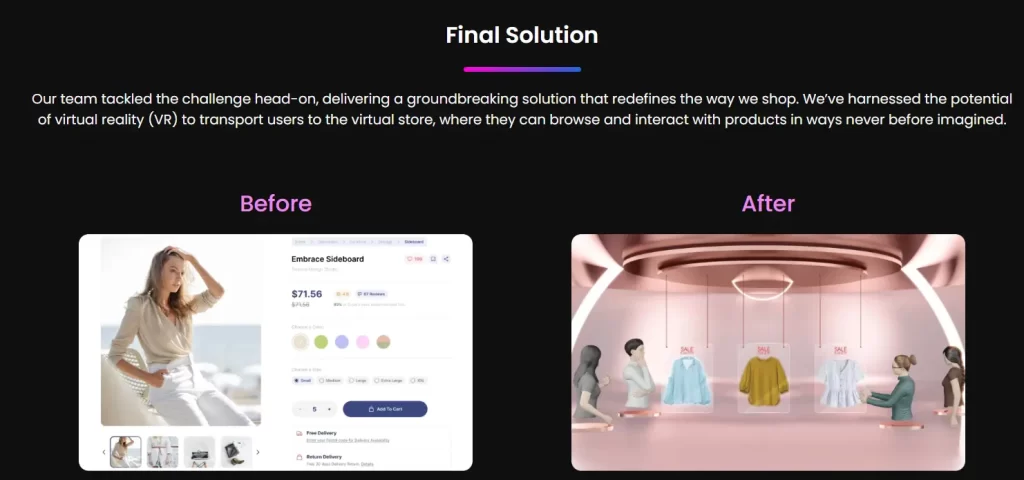
These are just a few cases of companies that we assisted with mobile app development as part of their digital transformation strategy. Explore our whole portfolio here.
Contact our specialists to see how we can assist you with enterprise app development for your specific company use case.
Work with Ex-MAANG developers to build next-gen apps schedule your consultation now
FAQ-
Q. What is digital transformation in enterprises?
A. Digital transformation in enterprises refers to the strategic integration of digital technologies into all aspects of business operations to fundamentally change how businesses operate and deliver value to customers. It involves leveraging technology to streamline processes, enhance efficiency, improve customer experience, and adapt to evolving market dynamics.
Q. How can mobile apps advance our enterprise digital transformation?
A. Mobile apps play a crucial role in advancing enterprise digital transformation by providing a platform for seamless communication, collaboration, and access to critical business information on the go. These apps enable employees to work remotely, access real-time data, and engage with customers more effectively, thereby enhancing productivity, innovation, and customer satisfaction.
Q. What is the role of applications in digital transformation?
A. Applications are central to digital transformation as they serve as the primary interface through which businesses interact with customers, employees, and partners. These applications encompass a wide range of software solutions, including mobile apps, web portals, cloud-based services, and enterprise software, that enable businesses to automate processes, analyze data, and deliver personalized experiences, driving operational efficiency, agility, and competitive advantage.
Q. How do you transform an organization into a digital one?
A. Transforming an organization into a digital one requires a holistic approach that encompasses strategic planning, cultural change, and technological innovation. Key steps include defining clear digital objectives aligned with business goals, fostering a culture of innovation and collaboration, investing in digital skills and capabilities, integrating digital technologies across business functions, and continuously iterating and adapting to evolving market trends and customer needs. It’s also essential to engage stakeholders at all levels, communicate the vision effectively, and measure progress through key performance indicators (KPIs) to ensure successful digital transformation.
